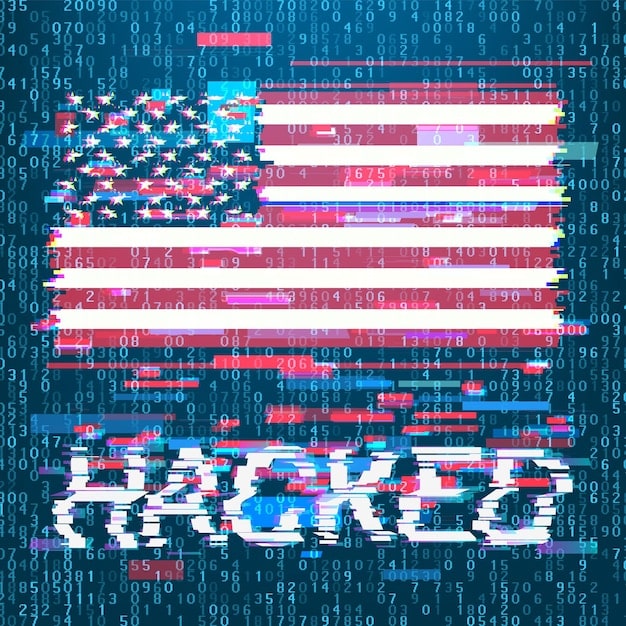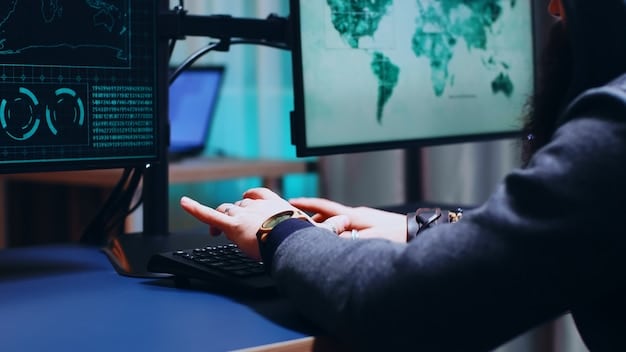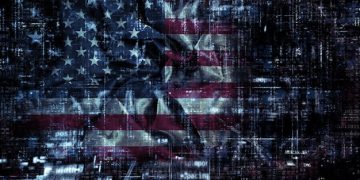Cyber Warfare and US Elections: 2025 Political Landscape

Cyber warfare poses a significant threat to US elections, with global conflicts influencing the strategies and tactics employed by malicious actors seeking to disrupt the democratic process and undermine public trust in the 2025 elections.
The intersection of cyber warfare and US elections presents a complex and evolving challenge, particularly as global conflicts increasingly shape the political landscape leading up to 2025. Understanding the nature of these threats is crucial for safeguarding the integrity of the democratic process.
The Escalating Threat of Cyber Warfare in Elections
Cyber warfare has emerged as a significant tool for nation-states and other actors seeking to influence elections worldwide. The methods employed are varied and constantly evolving, making defense a continuous challenge.
The sophistication of these attacks ranges from simple disinformation campaigns to complex intrusions into voting systems. Understanding the different types of threats is the first step in mitigating their impact.
Disinformation and Propaganda
Disinformation campaigns aim to manipulate public opinion through the spread of false or misleading information. Social media platforms are often the primary battleground for these campaigns.
Voter Registration Database Breaches
Cyber attacks targeting voter registration databases can sow chaos and confusion, potentially disenfranchising voters or undermining confidence in the electoral process.
- Identifying vulnerabilities in voter registration systems.
- Implementing multi-factor authentication for database access.
- Conducting regular security audits and penetration testing.
Ultimately, addressing the escalating threat of cyber warfare in elections requires a multi-faceted approach involving technological defenses, public awareness campaigns, and international cooperation.

Global Conflicts and Their Impact on US Election Security
Global conflicts create an environment ripe for cyber attacks targeting US elections. Adversaries may seek to exploit vulnerabilities to gain a strategic advantage or undermine the US’s global standing.
Understanding the motivations and capabilities of these actors is essential for developing effective defense strategies. Several countries have been identified as potential sources of cyber attacks.
Russian Interference
Russia has been implicated in numerous cyber attacks targeting US elections, including the hacking of the Democratic National Committee (DNC) in 2016.
Chinese Espionage
China has been accused of conducting cyber espionage campaigns aimed at stealing sensitive information and influencing US policy.
- Strengthening intelligence gathering and analysis capabilities.
- Developing robust cybersecurity partnerships with allies.
- Implementing sanctions and other measures to deter malicious cyber activity.
In summary, global conflicts significantly impact US election security by creating opportunities for foreign interference. Addressing this challenge requires a comprehensive strategy that combines deterrence, defense, and resilience.
Vulnerabilities in US Election Infrastructure
The US election infrastructure is a complex and decentralized system, making it inherently vulnerable to cyber attacks. Outdated voting machines, insecure networks, and a lack of standardization contribute to the problem.
Addressing these vulnerabilities requires a significant investment in modernization and security upgrades. Several key areas need immediate attention.
Outdated Voting Machines
Many voting machines in use across the US are outdated and lack modern security features, making them easy targets for hackers.
Insecure Networks
Election networks are often poorly secured and vulnerable to intrusion, allowing attackers to access sensitive data and disrupt election operations.
- Replacing outdated voting machines with modern, secure alternatives.
- Implementing robust network security protocols and firewalls.
- Conducting regular vulnerability assessments and penetration testing.
In conclusion, addressing vulnerabilities in US election infrastructure is critical for safeguarding the integrity of the democratic process. This requires a concerted effort by federal, state, and local governments, as well as the private sector.
Defensive Strategies for the 2025 Elections
Protecting the 2025 elections from cyber attacks requires a multi-layered defense strategy that addresses vulnerabilities at every level. This includes securing voting machines, protecting voter data, and combating disinformation.
Several key defensive strategies should be implemented to enhance election security. These strategies involve both technological and human elements.
Secure Voting Machines
Implementing rigorous security protocols for voting machines, including pre- and post-election audits, is essential for ensuring the integrity of the vote.
Protecting Voter Data
Safeguarding voter registration databases and other sensitive information is critical for preventing voter suppression and other forms of election interference.
- Implementing multi-factor authentication for all election-related systems.
- Conducting regular security awareness training for election officials and staff.
- Developing incident response plans to quickly address and mitigate cyber attacks.
To summarize, implementing effective defensive strategies is crucial for protecting the 2025 elections from cyber attacks. These strategies must be comprehensive, adaptable, and continuously updated to stay ahead of evolving threats.

The Role of International Cooperation
Cyber threats to elections are a global problem that requires international cooperation. Sharing information, coordinating responses, and establishing norms of behavior in cyberspace are essential for deterring malicious actors.
International cooperation can take many forms, from formal treaties to informal partnerships. Several key areas deserve attention.
Information Sharing
Sharing threat intelligence and best practices among countries can help improve collective defenses against cyber attacks.
Joint Exercises
Conducting joint cybersecurity exercises can help countries improve their ability to respond to cyber incidents and coordinate their efforts.
- Establishing clear norms of behavior in cyberspace.
- Developing mechanisms for attributing and responding to cyber attacks.
- Promoting international cooperation on cybersecurity standards and regulations.
Ultimately, international cooperation is essential for addressing the global challenge of cyber threats to elections. By working together, countries can improve their ability to deter, defend against, and respond to malicious cyber activity.
Public Awareness and Education
Public awareness and education are critical components of any comprehensive strategy to protect elections from cyber threats. Informed citizens are less likely to fall victim to disinformation campaigns and attempts at voter suppression.
Educational initiatives should focus on several key areas. These include media literacy, critical thinking, and cybersecurity awareness.
Media Literacy
Teaching citizens how to critically evaluate news and information sources can help them identify and avoid disinformation.
Critical Thinking
Encouraging citizens to question assumptions and think for themselves can make them less susceptible to manipulation.
- Developing public service announcements and educational materials on election security.
- Partnering with schools and community organizations to promote cybersecurity awareness.
- Encouraging social media platforms to combat disinformation and promote accurate information.
In conclusion, public awareness and education are essential for building resilience against cyber threats to elections. By empowering citizens with the knowledge and skills they need to protect themselves, we can strengthen the integrity of the democratic process.
Future Trends in Cyber Warfare and Elections
The landscape of cyber warfare and elections is constantly evolving, with new technologies and tactics emerging all the time. Staying ahead of these trends is essential for maintaining effective defenses.
Several key trends are likely to shape the future of cyber warfare and elections. These include the use of artificial intelligence, the rise of deepfakes, and the increasing sophistication of ransomware attacks.
Artificial Intelligence
AI can be used to automate and scale cyber attacks, making them more difficult to detect and defend against.
Deepfakes
Deepfakes are synthetic videos or audio recordings that can be used to spread disinformation and manipulate public opinion.
- Investing in research and development of AI-powered cybersecurity tools.
- Developing techniques for detecting and countering deepfakes.
- Strengthening partnerships between government, industry, and academia.
In summary, understanding future trends in cyber warfare and elections is essential for staying ahead of evolving threats. By anticipating these trends and investing in appropriate defenses, we can protect the integrity of the democratic process in the years to come.
| Key Topic | Brief Description |
|---|---|
| 🛡️ Cyber Warfare | Includes disinformation, hacking, and attacks on election infrastructure. |
| 🌍 Global Conflicts | Fuel cyber attacks on US elections by various actors. |
| 🗳️ Election Security | Requires defensive strategies, voter protection, and international cooperation. |
| 📢 Public Awareness | Involves media literacy and cybersecurity education. |
Frequently Asked Questions
▼
Cyber warfare involves the use of technology to attack or disrupt an opponent’s computer systems or networks. This includes activities like hacking, spreading disinformation, and disrupting critical infrastructure.
▼
Global conflicts can motivate foreign actors to interfere in US elections through cyber attacks to advance their strategic interests or undermine US influence on the world stage.
▼
US election infrastructure faces vulnerabilities like outdated voting machines, insecure networks, and a lack of standardized security measures across different states and localities.
▼
Defensive strategies include securing voting machines, protecting voter data, conducting regular security audits, and raising public awareness about disinformation campaigns and cybersecurity risks.
▼
International cooperation allows countries to share threat intelligence, coordinate responses to cyber attacks, and establish global norms of behavior in cyberspace to deter malicious actors.
Conclusion
In conclusion, the threat of cyber warfare and US elections is a complex issue that requires a multi-faceted approach. By understanding the evolving nature of these threats, addressing vulnerabilities in election infrastructure, and promoting public awareness, we can work to protect the democratic process and ensure the integrity of future elections.





